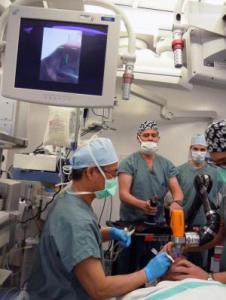Dr Thomas M Hemmerling from the McGill University Health Center (MUHC) who is also a Professor of Anesthesia along with his team members has developed a new intubation robotic system called Kepler Intubation System (KIS).
This system has been used for the first time on a patient at the Montreal General Hospital. This system facilitates intubation procedure and also decreases the complications that normally come along with airway management.
 Kepler Intubation System (KIS)
Kepler Intubation System (KIS)
Dr. Hemmerling reveals that this system would include a robotic mounted video laryngoscope fitted with a joystick, which could be operated from a remote workstation. He also states that this system would help the anesthesiologist to slot in an endotracheal tube into the patient’s trachea with great precision and safety. This tube would then facilitate artificial ventilation, which is utilized in most of the general anesthesia patients. To insert correctly the tube into the trachea is a complex task requiring extensive experience and practice. According to him, complications and difficulties prevail, mainly due to patient characteristics but differences also abound in individual airway management skills, which could affect the performance of the procedure. However, all this could be greatly reduced if KIS is utilized. After carrying out several tests in the airways of medical simulation mannequins successfully, clinical testing on patients has now commenced.
According to Dr. Armen Aprikian, the Director of the Department of Urology in MUHC, high tech equipment and tools have completely transformed the way surgery was being done, as they allow the surgeon to operate with greater precision and nil physical effort. After using KIS, he revealed that KIS would do all for anesthesia that was done by these systems for surgeries.
The World’s first anesthesia robot named McSleepy TM was developed in Hemmerling’s laboratory in 2008 for providing automated anesthesia. Hemmerling states that the KIS could help the anesthesiologist’s hands and arms for performing manual jobs with much less force, greater safety and precision. He feels that one day this system would definitely become the standard practice of airway management.